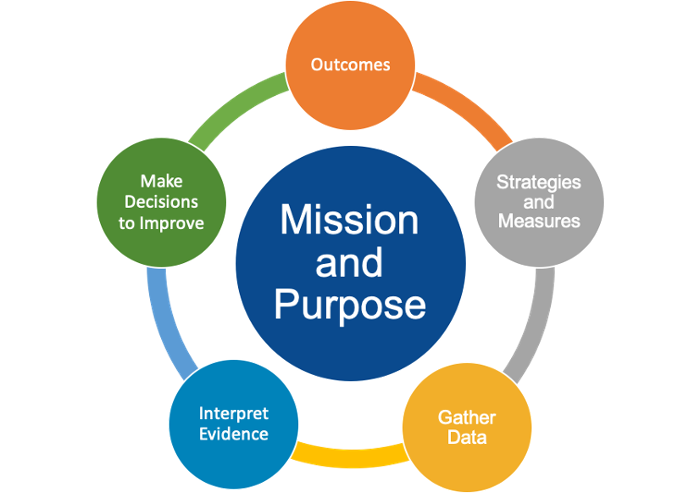Educational Programs Assessment
In accordance with our regional accreditor, SACSCOC, each educational program at Emory submits an assessment report every two years to be reviewed by the Learning Outcomes Assessment Committee. These reports include a thorough accounting of the program's learning outcomes, measures, data, and analysis. It also includes any and all changes the program plans to make based on its interpretation of that assessment cycle's information. Below are the report template as well as the rubric used by the committee for evaluation. Please review these documents and contact us if you have any questions.
Review Documents

Learning outcomes assessment has several phases that proceed in a consistent cycle, with a goal of constantly seeking improvement. Below we have outlined each of the stages of the assessment cycle. Included under each are a brief description and several linked resources for more information and examples regarding that topic.
Learning Outcomes
Learning outcomes describe what students are able to demonstrate in terms of knowledge, skills, and dispositions upon completion of a course, a span of several courses, or a program. Clear articulation of learning outcomes serves as the foundation of evaluating the effectiveness of the teaching and learning process.
Learning Outcomes – DePaul University
How to Write Outcomes – University of Connecticut
Using Bloom's Taxonomy to Write Outcomes – University of Arkansas
Measures
Assessment measures are tools and techniques used to determine the extent to which the stated learning outcomes are achieved. A variety of methods, qualitative and quantitative, direct and indirect, should be used to best measure the depth and breadth of a program. Examples shown are adapted from Gavilan College.
Performance assessment for graduating seniors
Writing proficiency exams
National Major Field Achievement Tests
GRE subject exams
Certification exams, licensure exams
Locally developed pre- and post- tests
Senior thesis / major project
Portfolio evaluation
Reflective journals
Capstone course assignments
Internship evaluations
Artifacts graded with scoring rubrics
Employer surveys
Graduate school acceptance rates
Performance in graduate school
Student graduation/retention rates
Exit interviews
Focus group discussion
Alumni surveys
Tracking of alumni awards, achievements (national, state, international, etc.)
Curriculum/syllabus analysis
Measure Types – University of Wisconsin Stevens Point
VALUE Rubrics – Association of American Colleges & Universities
Video Tutorial – Direct vs. Indirect Measures
Analysis
The assessment results need to be analyzed to learn whether or not the criteria of the student learning outcomes were met. To give meaning to the information that has been collected, it needs to be analyzed for context, understanding, and to draw conclusions. This step gives the information meaning; it is essential to effectively communicate and utilize the assessment results.
Analysis of Assessment Results – Cal Poly University
Interpreting Assessment Results – Northern Arizona University
Use of Results
The intent of assessment is to identify strengths and weaknesses and then to implement changes in an effort to improve the program. These changes could impact a number of aspects of the program: curriculum, staffing, facilities, internal processes, and intended student learning outcomes.
Reporting and Use of Assessment Results – James Madison University
Using Assessment Results for Program Improvement – Cal Poly University
Best Practices
While allowing for differences in specific assessment strategies among the disciplines, the University Assessment Committee expects each educational program to conduct assessment procedures according to the following best practices:
- Program faculty members identify student learning outcomes, develop assessment measures, analyze results, determine appropriate improvements, and write assessment reports.
- Programs establish clearly defined, measurable student learning outcomes that focus on knowledge, skills, behaviors, or values.
- Programs use direct assessment methods (e.g., examinations, research essays, theses, oral presentations, capstone projects, portfolios, performances, etc.) as their primary means of assessing student learning outcomes.
- Programs use indirect assessment methods (surveys, questionnaires, focus groups, interviews, etc.) as secondary means of assessing student learning outcomes.
- Assessment measures clearly address the degree to which students attain defined learning outcomes.
- Assessment measures are distinct from course grades and teaching evaluations (but they may involve graded materials).
- Data and information are collected over time and analyzed longitudinally.
- Improvements in programs and student learning are planned and enacted in response to assessment findings.
- All program-level student learning outcomes are assessed within three- to five-year cycles.
- Assessment reports are completed every two years, evaluated by appropriate faculty committees, and collected by the Office of Planning and Adminstration.